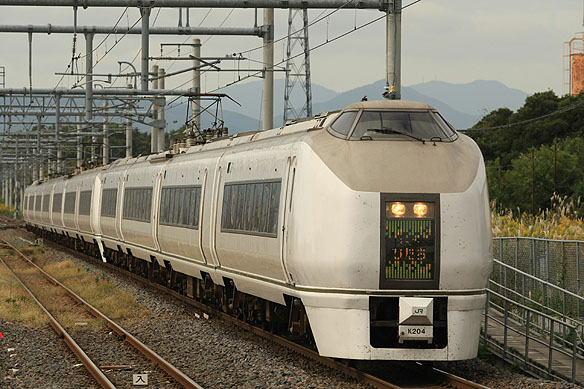Background and overview
JR East developed the next generation dual voltage AC/DC electric multiple unit (EMU) trainset, 651 series, to compete against high-speed bus services of extending Joban Expressway and displace superannuated 485 series EMU used on "Hitachi" intercity services. 651 series targeted a businessman are developed under the focus on hospitality. 6 seven-car long sets and 4 four-car short sets were delivered to adjust the fluctuation difference of transport capacity between to the south of Mito and to the north of Hitachi in 1989.
Car body
They have 2900mm wide body. Their body design incorporates a weatherproof steel sheet (Steel Plate Atmospheric) specified by Japanese national Railways' standard, and a stainless plate for their roof and floor. Their floor level is made 55mm lower than that of 485 series to reduce the level difference against the platforms and for the door step to be discontinued. The end section of the train is no gangwayed featuring raised driver's cab, and a large LED indicator carrying the function of tail lights. They are equipped with two 730mm wide single-leaf sliding doors for standard class vehicles or one door for the 1st class vehicle, and the horizontal band fixed windows adopting the double-glazing bronze glass on each side of their body. Traditional destination rollsigns are fitted on the body. Two air conditioners, AU711, rated at 14,000kcal/h/unit, are fitted on their roof. Cover plates are also fitted on their roof throughout to hide air conditioner units. Their livery is milky white with their window frames and underframe painted in grayish-brown and upper frieze board painted in sand gray. End cars are equipped with the automatic jumper coupler to ease rush-up operations.
Bogies
Motored bogies are DT56 and trailer bogies are TR241, featuring bolster-less
secondary air suspension, rolled rubber spring journal supporting system,
and the Watts linkage draw gear. Their bogies also employ the yaw dampers
to ensure smooth ride characteristics even at 130km/h. Motored bogies employ
single tread brake device and trailer bogies employ both single disk brake
device and single tread brake device.
Traction unit and ancillary equipments
Eight series-wound brushed DC traction motors, MT61A, with a power output
of 120kW are controlled by a traction system, CS57B, featuring field added
excitation control and fitted on class moha651 vehicles to realize maximum
service speed at 130km/h and regenerative braking on the DC electrified
line. CS57B adopts married pair system to control two motored vehicles,
class moha651 and moha650 together. The gear ratio is 3.95. Class moha650
powered intermediate vehicles are equipped with a traction controllable
rectifier, RS51, featuring cascaded connecting full thyristor bridge functioned
as a converter while power running and an external excited inverter while
regenerative braking on the AC electrified line, and a traction transformer,
TM24, designed only for AC 50Hz to realize 20% lighter than former TM20
for both 50Hz and 60Hz under their floor. Their traction system introduced
the constant speed drive function over 80km/h. The brake system is the
electric command pneumatic brake, employing anti-slip control by axle-driven
tachometer generator fitted to each axle in order to achieve brake performance
efficiently even at 130km/h. Class moha680 powered intermediate vehicles
are also equipped with a diamond-shaped current pickup, PS26, having some
improvement based on PS25X trial current pickup on the roof
PS26 gets improved tracking performance against a current feeder and lighter
body. Tailer end vehicles excepting class kuha651-100 are equipped with
a brush-less motor generator with a power output of 120kVA and a motor
driven air compressor, MH3094-C2000LB under their floor.
Accommodation
All seats are adjustable reclining. 1st class vehicles have 2+1 abreast seating with 1160mm seating pitch and standard class vehicles have 2+2 abreast seating with 970mm seating pitch. The baggage shelf to store large suitcases is fitted at the end of the passenger saloon. A glass partition is fitted at the centre of 1st class passenger saloon to divide into smoking seats and nonsmoking seats. Their luggage rack of 1st class vehicles employs the airplane overhead bin style. LCD TV sets for satellite television programme and audio control units for audio programme are provided at each seat of the 1st class. A door between a vestibule and a passenger saloon is automatic, detecting by the photo sensor. A LED display for providing passenger information is fitted above the door between a vestibule and a passenger saloon. Class saro651, moha651, and kuha650 vehicles are equipped with a western style toilet, a flushing urinal, and a washroom. Class moha651-100 vehicles are equipped with a universal access toilet and a multi-purpose room. Each toilet has a chemical holding tank. A conductor room is located in class saro651 vehicles.
Operations
651 series EMU entered "Super Hitachi" intercity revenue services in March, 1989. Four 7-car sets and sin 4-car sets were additionally delivered in 1989. They were also used on "Fresh Hitachi" intercity services later. However, they were withdrawn because of displacement to E657 series EMU in 2010. Some vehicles were remodeled and classified into -1000 subseries in order to transfer into the Takasaki line intercity services, and the others were scrapped completely in 2020. |
|

